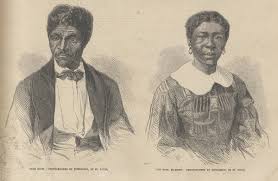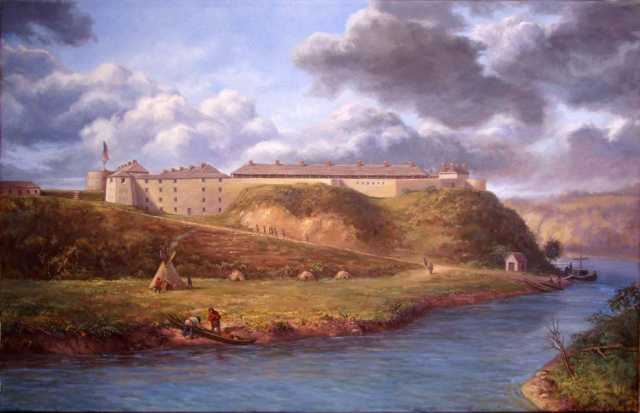The Dred Scott Trials
The Dred Scott Trials (1846-1854)
by Douglas O. Linder (2019)

Dred and Harriet Scott
Chief Justice Robert Taney’s opinion for the Supreme Court’s 1856 decision in Dred Scott v Sandford is often called the worst in its long history. Charles Evans Hughes, before he became Chief Justice, called the Dred Scott decision our “great self-inflicted wound.”
Both of the two key holdings in Dred Scott v Sandford damaged the long-term reputation of the Court. First, Taney concluded that Dred Scott, an African-American born in the United States, was not a citizen and therefore could not sue in federal courts. Second, the Court held Congress lacked the power under the Constitution to ban slavery in the western territories, thus making any compromise between northern and southern interests on the slave question impossible. The Dred Scott decision therefore set the country on a virtually inevitable course for war. It was arguably the most consequential decision the Supreme Court ever made.
So how did this case make its way to the Court? Like many landmark decisions, it had its origins in the simple desire of one individual, who felt himself a victim of injustice, to seek a court’s help in vindicating his rights.
Background
Dred Scott was born a slave in Southhampton County, in Virginia, around 1800. Dred’s master, Peter Blow, had a large plantation in southwestern Virginia, and later a farm in Alabama. In 1930, at the age of 53, Peter decided to give up farming and take a new course. Peter and his wife, three daughters, and four sons, moved to St. Louis, taking Dred and his other slaves with them.
In the flourishing river city of St. Louis, Blow ran a boarding house called the Jefferson Hotel. But things didn’t work out as Peter hoped. His wife died and his boarding business turned out to be unsuccessful. Peter abandoned the venture and moved his family into another house in 1832. His own health then quickly deteriorated. Peter Blow died in June, 1832.
By 1833, Dred Scott had a new master, Dr. John Emerson, an assistant surgeon in the U. S. Army then stationed at Jefferson Barracks near St. Louis. But Peter Blow’s children, especially Taylor Blow who was age 12 at the time he was orphaned, continued to have a protective interest in their old slave. Most likely, Taylor Blow considered Dred a friend as much as a slave. Taylor Blow would become Dred’s most important supporter in Dred’s long fight for freedom.
In December 1833, Dr. Emerson was ordered to report for duty at Fort Armstrong, 200 miles north of St. Louis in the free state of Illinois. He took Dred, who worked as Emerson’s personal servant at the post, with him.
Fort Armstrong was lacking in amenities, and only two months after his arrival in Illinois, Dr. Emerson began campaigning for a transfer. He was not immediately successful, but in 1836 the Army decided to abandon Fort Armstrong and Emerson was transferred further north to Fort Snelling on a bluff above the Upper Mississippi in the Wisconsin Territory (a site in what is present-day St. Paul, Minnesota). The Wisconsin Territory, like Illinois, prohibited slavery.
While working for Emerson at Fort Snelling, Dred met and fell for another slave stationed at the Fort, Harriet Robinson, who belonged to Major Lawrence Taliaferro, a nearby Indian agent. The major, who also served as the local justice of the peace, married Dred and Harriet. The couple would remain married for the rest of Dred’s life. They would have four children, two daughter of which survived infancy and would become parties in the Scotts’ suit for freedom.
Dr. Emerson complained about the winter weather and requested a transfer back to St. Louis, which he received in the fall of 1837. But when he arrived back in St. Louis, leaving Scott behind at Fort Snelling to work for another officer, new orders sent him on to Fort Jesup in western Louisiana. The doctor soon concluded that his new post was much worse than Fort Snelling, which by now he called the “best post” in the country. He took time off from his complaining, however, to marry Eliza Irene Sanford of St. Louis in February 1838.
After his marriage, Emerson sent word that he wanted Dred and Harriet Scott transported down to his post in Louisiana. They made the journey mostly by steamboat. Little is known of their short stay at Fort Jesup.
By September 1838, Emerson had been transferred again and was making his way back north to Fort Snelling. Together with the Scotts, Emerson rode up the Mississippi on the stern wheeler Gypsy, arriving at the Fort in late October. Somewhere on the riverboat journey, north of the Missouri line, Harriet gave birth to the couple’s first child, Eliza.

Fort Snelling in the Wisconsin Territory (present-day St. Paul, Minnesota)
Emerson’s stay at Fort Snelling would be cut short, however. The doctor, apparently, got into an argument with the quartermaster over whether the Scott’s should be provided with a stove. When the quartermaster refused, a fight ensued, resulting in Emerson’s glasses being broken. He returned to the scene later waving two pistols, according to the story—all of which was too much for the post commander, who placed Emerson under arrest. In 1840, Emerson was ordered off to Florida, where the Seminole War was making things messy. The Scotts traveled with Emerson as far as St. Louis, where they were dropped off and either employed by Emerson’s wife or hired out. It seems very likely that at this time Dred Scott renewed his relationship with the Blows.
In 1842, the Army gave Emerson an honorable dismissal from the service. He returned to St. Louis for a brief time and then moved to Davenport in the Iowa Territory, where he began offering medical services and, while living in a hotel, started construction on a house. The Scotts, meanwhile, remained in St. Louis.
In December 1843, Dr. Emerson died, most likely of syphilis. His will made his wife, Irene Emerson, the holder of an estate for life, with his daughter, Henrietta, designated to take ownership of his property upon Irene’s death. Shortly after Emerson’s death, the Scotts seem to have been loaned to a brother-in-law of Irene’s, Captain Bainbridge. For the next three years, the Scotts served Bainbridge, who moved from the Jefferson Barracks to Fort Jesup in Louisiana, and finally to a post in Corpus Christi, Texas. When war broke out with Mexico, Captain Bainbridge sent the Scotts back to St. Louis, where Irene Emerson hired them both out to a man named Samuel Russell.
Soon after beginning work for Russell, Dred Scott would set in motion legal action that would ultimately change the course of the nation’s history.
Dred and Harriet Scott’s Suits for Freedom
Scott tried to purchase freedom for him and his family from Irene Emerson, but for unknown reasons, she refused. In April 1946, Scotts filed suit in St. Louis circuit court for the freedom of themselves and their two daughters, Eliza and Lizzie. Despite some the suggestion of some historians to the contrary, there is little or no evidence that the suit was brought to serve broad political goals; the Scotts (probably after having discussions with the Blows and other sympathetic acquaintances) simply wanted to be free. It is likely that Taylor Blow provided financial support for the litigation. The complaint claimed Emerson had “beat, bruised, and ill-treated” Scott, and that Scott was a free person wrongly held in slavery, and claimed damages of ten dollars. . . . Continued
